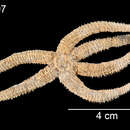Comprehensive Description
(
anglais
)
fourni par Smithsonian Contributions to Zoology
Ampheraster alaminos Downey, 1971c:51–54
This species has six arms, whereas other species in the genus are regularly five armed. The skeleton is weaker and more irregular than that of A. hyperoncus, and the arms are weakly attached to the disc. On the dorsal surface, there is a large clear patch of thin, uncalcified tissue between the base of the arms and the disc, with, at most, one or two small carinal plates between the arm and the disc. In contrast, the enlarged interbrachial superomarginals, warped and bent and rather thin, form, together with the heavy calcareous interbrachial septa, six strong and rigid areas around the periphery of the disc. The superomarginal plates are generally four lobed, and imbricate in straight (not zigzag) series. The upper lobe is usually reduced, while the lower lobe is greatly elongated, overlapping the corresponding inferomarginal plate. The small disc has a dorsum of thin tissue and a circlet of elongate primary plates, with a few unattached elongate plates in the center. Each plate bears a few short, thorny, aciculate spines, and the madreporite, borne on one of the interradial primaries, is of moderate size, covered with deep coarse gyri, and bearing around its periphery a circlet of spines.
Elsewhere the disc is covered with large straight unguiculate pedicellariae. The surface of the arms is completely covered with small crossed pedicellariae. The small carinal plates are more or less irregular, and there are two series of meshes on either side of the carinal row. The adambulacral plates bear a single (occasionally two) long ridged, aciculate spine, and the inferomarginal plates bear a similar, somewhat shorter spine; above the inferomarginals, the superomarginals, dorsolaterals, and carinals may bear a single, short spine, or no spine. Straight unguiculate pedicellariae are abundant on the actinal disc interradii, and also occur between the proximal adambulacral plates and the inferomarginals. A few smaller pedicellariae of this type occur within the groove. The long, narrow mouth plates bear two long, slender, divergent spines on the side of the straight bare apex, and 2 or 3 similar suboral spines, one behind the other. The mouth plates also bear a number of small unguiculate pedicellariae.
All of the specimens of this species are from depths of 1,450 to 1,750 fathpms, in the north central Gulf of Mexico, where the bottom is mainly foraminiferal.
MATERIAL EXAMINED.–Alaminos Stations: 3C/68–A–7 (1 holotype) [R=62 mm, r=8 mm, Rr=1:7]; 4E/68–A–7 (1, pluss 44 arms, 1 disc) [R=47 mm, r=4 mm, Rr=1:11]; 4A/68–A–7 (9) [R=42 mm, r=4 mm, Rr=1:10]. Oregon Station 2547 (1) [R=50 mm, r=5 mm, Rr=1:10].
Sclerasterias Perrier
Sclerasterias Perrier, 1891b:1227. [Type, by original designation, S. guernei Perrier.]
Eustolasterias Fisher, 1923:255. [Type, by original designation, Coscinasterias (Distolasterias) euplecta Fisher.]
Dorsal skeleton regular, with two series of skeletal meshes on either side of prominent carinal ridge; inferomarginal plates with two spines, only outer one carrying cluster of crossed pedicellariae; adambulacral plates diplacanthid throughout; straight pedicellariae lanceolate; outer inferomarginal spines webbed together at base; alternate superomarginals usually spineless; carinal, marginal, and actinal plates in regular longitudinal series; small obtuse spines above inferomarginals wreathed by collar of small crossed pedicellariae; adults regularly five-armed, but young may be six-armed and fissiparous.
Only one species occurs in the area covered by this report. S. tanneri (Verrill), a more nothern species, is generally much smaller and bears a spine on every carinal plate, rather than every other one. S. subangulosa (Verrill) (=Orthasterias (Stylasterias) subangulosa Verrill=Asterias angulosa Perrier) was rightly considered the young of S. contorta by Fisher (1928a).
- citation bibliographique
- Downey, Maureen E. 1973. "Starfishes from the Caribbean and the Gulf of Mexico." Smithsonian Contributions to Zoology. 1-158. https://doi.org/10.5479/si.00810282.126

